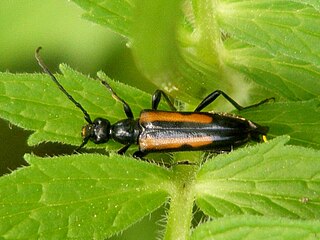
Anisocerus is a genus of long-horned beetles in the family Cerambycidae. There are at least two described species in Anisocerus.
Neomallodon is a genus of beetles in the family Cerambycidae. It is monotypic, being represented by the single species Neomallodon arizonicus.

Strangalepta is a genus containing only one species, Strangalepta abbreviata, a longhorned beetle in the family Cerambycidae.
Acmaeopsoides rufula is a species of beetle in the family Cerambycidae, and the only species in the genus Acmaeopsoides. This beetle is distributed in Canada, and United States.
Piodes coriacea is a species of long-horn beetle in the family Cerambycidae, the only species in the genus Piodes. This beetle is distributed in United States.
Pseudoxylosteus is a genus of flower longhorn beetles in the family Cerambycidae. There is a single species in Pseudoxylosteus, P. ornatus, found in the western United States. It is about 10 mm in length.

Plocaederus is a genus of Long-Horned Beetles in the beetle family Cerambycidae. This genus has a single species, Plocaederus bellator. It is known from the South American countries Brazil, Ecuador, Guyana, French Guiana, Paraguay, and Suriname.
Dioridium is a genus of beetles in the family Cerambycidae, containing the following species:
Hemilissa is a genus of beetles in the family Cerambycidae, containing the following species:
Migmocera flavicauda is a species of longhorn beetles belonging to the family Cerambycidae, the only species in the genus Migmocera.
Carenoptomerus guyanensis is a species of beetle in the family Cerambycidae, the only species in the genus Carenoptomerus.
Lepturgantes is a genus of beetles in the family Cerambycidae. The genus is placed in subfamily Lamiinae and tribe Acanthocinini.
Phantazoderus frenatus is a species of longhorn beetle in the Cerambycinae subfamily, and the only species in the genus Phantazoderus. The species was described by Léon Fairmaire and Jean-François Germain in 1864. It is known from Chile and southern Argentina. In flight, Phantazoderus frenatus is easily confused with species of Pyractomena, with which it shares coloration. Its rarity may be due to the density relationship with its model, as a remnant of Batesian mimicry.

Anelaphus villosus, the twig pruner, is a species in the longhorn beetle family Cerambycidae. It is found in the eastern half of the United States and southeastern Canada.
Eclipta faurei is a species of beetle in the family Cerambycidae. It was described by Peñaherrera-Leiva and Tavakilian in 2003. It is known from French Guiana and Rondônia, central-western Brazil.
Oxylymma durantoni is a species of beetle in the family Cerambycidae. It was described by Peñaherrera-Leiva and Tavakilian in 2003. It is known from French Guiana and Pará, northern Brazil.
Oxylymma sudrei is a species of beetle in the family Cerambycidae. It was described by Peñaherrera-Leiva and Tavakilian in 2003. It is known from French Guiana and Amapá, northern Brazil.
Rhopalophora prolixa is a species of beetle belonging to the family Cerambycidae. First described by Monné in 1989, this beetle is part of the vast and diverse world of longhorn beetles.
Dmytro Zajciw was a Ukrainian and Brazilian entomologist, notable for his many beetle discoveries and for his collection. He was born in Velyka Mykhailivka, Ukraine and died in Rio de Janeiro, Brazil. He was the author of Two new genera and species of neotropical Longhorn beetles , 1957, Contribution to the study of Longhorn beetles of Rio de Janeiro , 1958, and was the first to describe the genera Adesmoides and Pseudogrammopsis, as well as the species Beraba angusticollis and Mionochroma subaurosum, among many others.
Ulochaetes leoninus, the lion beetle, is a species of long-horned beetle in the family Cerambycidae. It is found in North America.




